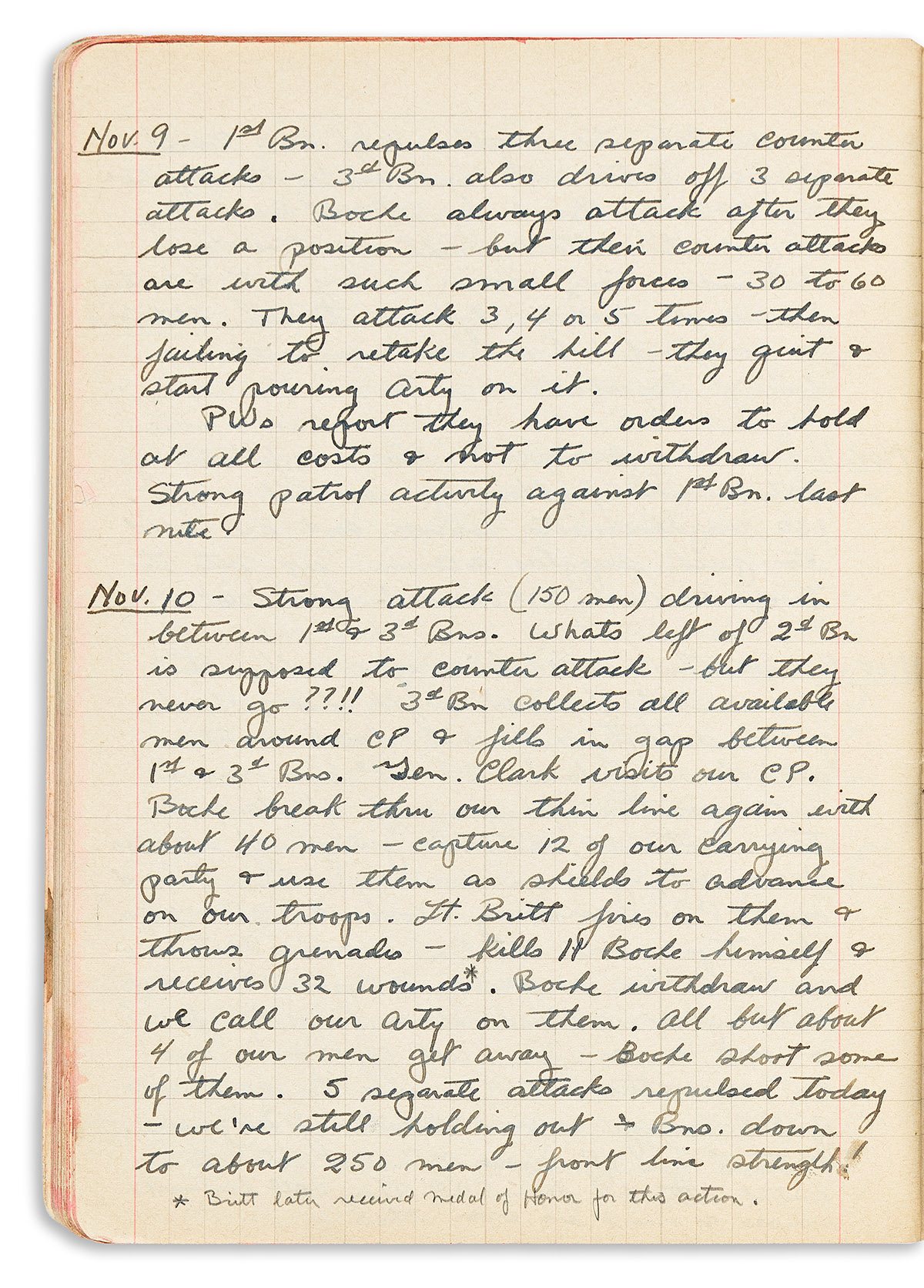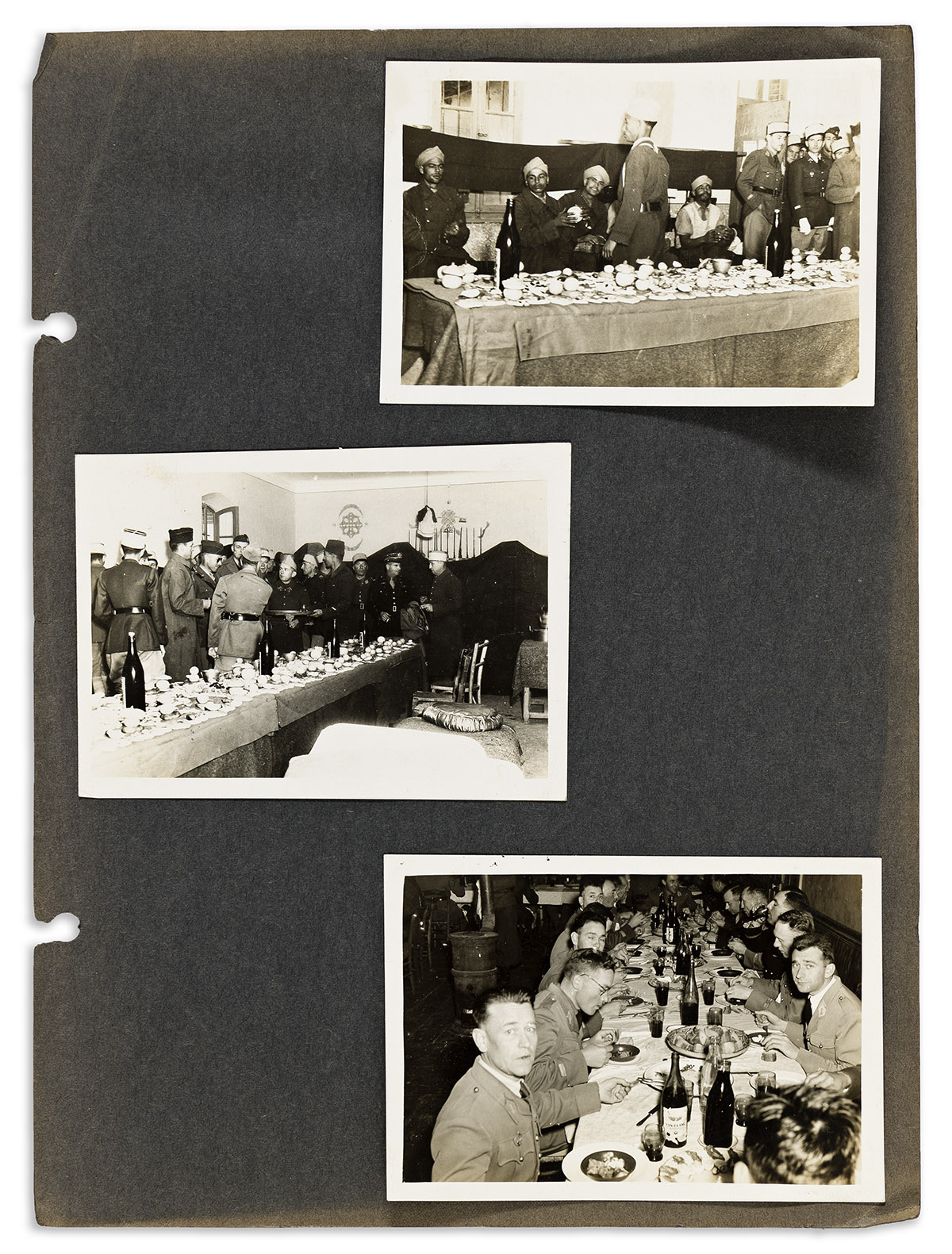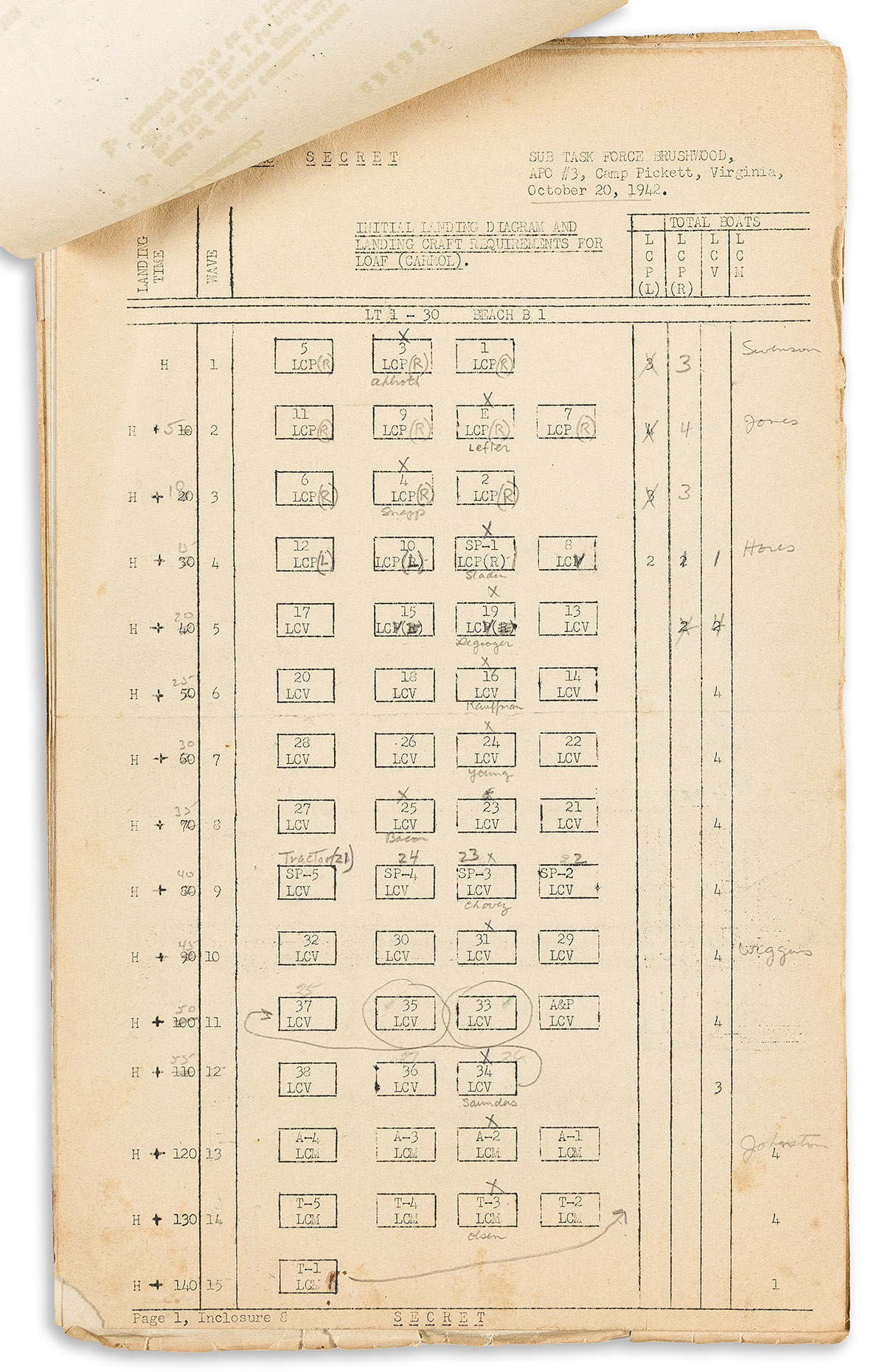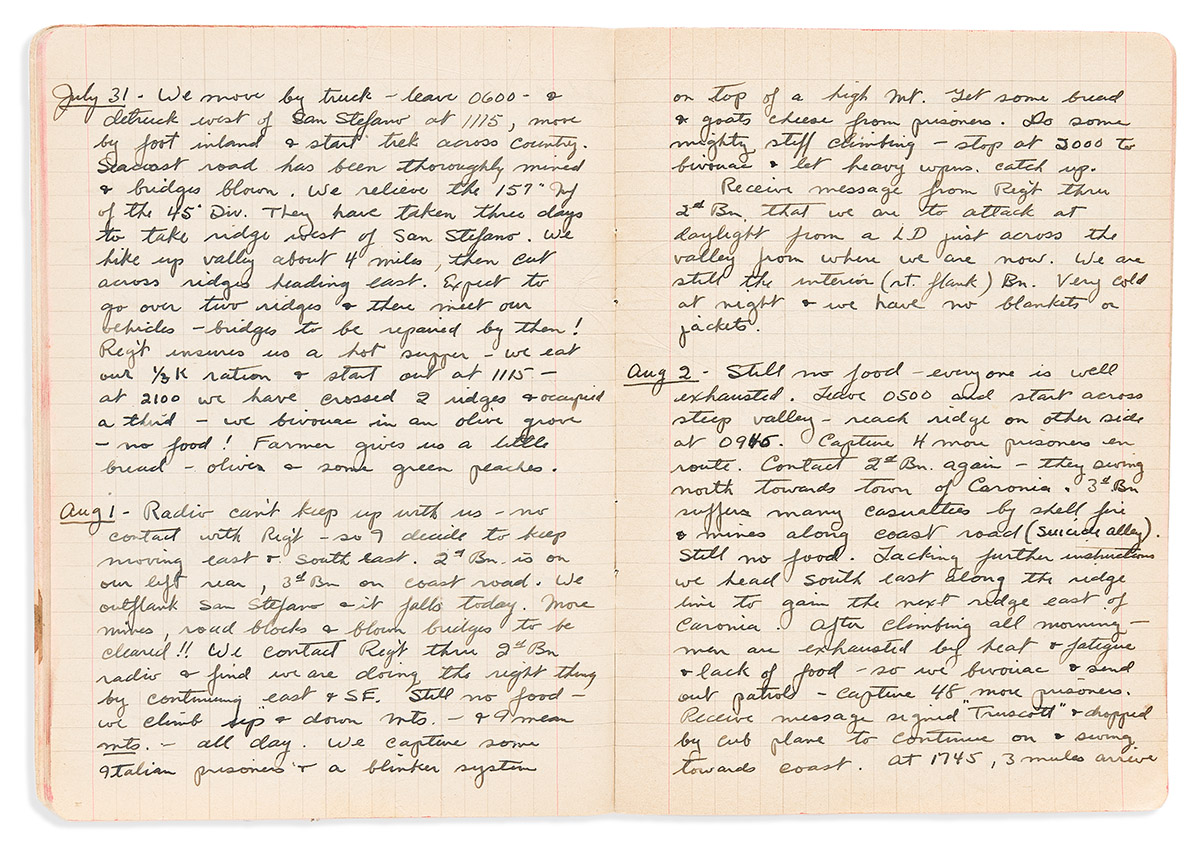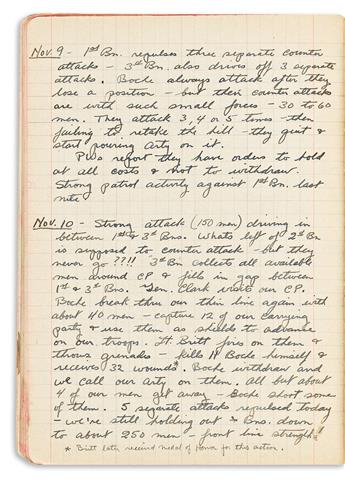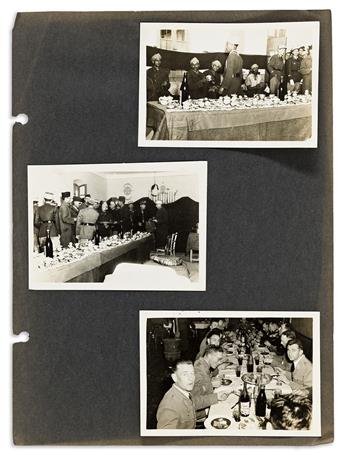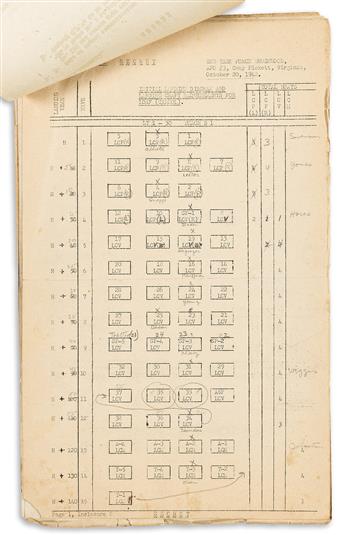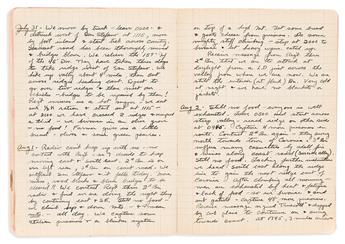Sale 2687 - Lot 261
Unsold
Estimate: $ 3,000 - $ 4,000
(WORLD WAR TWO.) Fred W. Sladen. Riveting diaries of a colonel commanding troops from Morocco to Italy to France, with other papers. 14 items (0.4 linear feet) featuring 2 diary volumes with [74], [99] manuscript pages, the first a clean early copy followed by a pencil draft with entries crossed through; generally minor wear. Various places, 1942-1945
Additional Details
Fred Winchester "Jim" Sladen Jr. (1906-1980) was a third-generation army officer; his father had been a major general and head of West Point. He graduated from West Point in 1929 and rose to the rank of Lieutenant Colonel by November 1942, commanding the first battalion of the 30th Infantry Regiment. He was a fine writer.
The two diaries in this collection begin on 8 November 1942 and end on 26 November 1944. They begin with the invasion of North Africa in Operation Torch. Sladen's regiment was part of the Western Task Force under General Patton which took Casablanca in French Morocco: "A search light from Fort Blondin comes on and falls right across our wave. The scout boat marking our beach takes off to shoot out the light. 50 cal. MG fire starts falling around our boat. A 100 mm. shell from Pt. Fedala lands under the stern & lifts us out of the water. Next minute we land on submerged rocks, about 0520. We're stuck, can't go forward or back. We lower the ramp and start jumping into the water." That's just the first page.
As the army marches up the Moroccan coast and assumes control from the French collaborationists, they settle into the "hearts and minds" work of establishing good relations with the local French and Arabs. Sladen appreciates food and local color. On 29 November 1942 he notes in Rabat: "Hunting party returns to a farm house at 1400 & Mme. Imbert has 2 lambs roasting on spits. We all sit down with the Arab chiefs to a feast of cous-cous, wine, cheese, floating island, coffee & rhum." By 3 May 1943, they are in Beni Mansour, Algeria; arrived in Tunisia on 7 May; and began preparing for the invasion of Sicily in Operation Husky.
On 4 July, "we are told we will embark tomorrow!! . . . Not much time for careful study!!" They land in Sicily on 10 July: "We land on right beach & in about waist deep water. Luckily art'y barrage lifts as we reach wire on beach. We cut paths thru wire and move on inland as quickly as possible. . . . I go with the right Co., Co. A. I get one Italian with my carbine--he was firing at us from behind a haystack. . . . A Co. cleans up 3 pillboxes and takes 15 prisoners, then starts up hill to fort." Marching through the mountains of Sicily, "we outflanked the Boche on each ridge & made them withdraw--only fired one shot & captured 58 prisoners!!" (2 August 1943). They reach Messina on 17 August as the Axis complete their evacuation of Sicily: "We see Italy for first time. . . . Command Post on high hill overlooking the strait. Small private tennis club with dining room, kitchen & sun porch on roof. Wonderful breeze & beautiful view. Sicilian Campaign is over!!"
Working their way up Italy, the regiment encounters heavy opposition from the Germans. Sladen recounts the fine work of the regiment's most famous war hero, Lieutenant Maurice Britt of the 3rd Battalion, at Monte Rotondo: "Boche break through our thin line again with about 40 men, capture 12 of our carrying party & use them as shields to advance on our troops. Lt. Britt fires on them & throws grenades, kills 11 Boche himself & receives 32 wounds." Sladen notes with an asterisk that "Britt later received a Medal of Honor for this action."
On 6 February 1944, Sladen is detailed to serve on the staff of the 36th Division, working with General Fred L. Walker. General Mark Clark is also frequently discussed. On leave in Sorrento on 8 April 1944, he offers a soldier's take on Pompeii: "It looks just like any other ruined town I've seen except for the rubble is cleaned up." As a staff officer, he sees less fighting up close, but participates in Anzio and Operation Diadem: "Gen. Stack & I go up to Cisterna, watch street fighting & see our troops capture 35 prisoners from one building" (25 May 1944). Regarding the order of battle for 30 May, "Gen. Stack & I dream up a better plan. I sell it to Ben Howell, G-3 Corps & he gets it okeyed. We hurriedly change our plans & make an end run around our right flank into mts." They pass through Rome on 5 June, and then while crossing a river on 15 June, "at first all civilians flee & hide, then when I tell them Americano the whole town bursts into streets, waving flags, throwing flowers & offering us drinks of cognac."
Major General John E. Dahlquist takes over the 36th Division on 9 July 1944. Dahlquist has been held responsible for the horrific losses suffered by the Japanese-American 442nd Infantry while rescuing a surrounded regiment near St.-Die in France, discussed here in detail from 25 to 31 October 1944. Sladen heads back stateside on 25 November 1944, ending the diary--one of the most all-around entertaining World War Two diaries we have seen.
The other papers in this lot include: 22 photos and other documents on 6 album leaves.
A binder with a battered aerial view landing photo of Morocco's Fedala Beach, a sketch map of Fedala, and 18 road maps of Africa, Italy and France, plus 3 other loose maps.
A secret mimeograph field order on Operation Torch from Sladen's battalion dated 28 October 1942 including an initial landing diagram.
"The Capture of Velletri and the Colle Laziale," long mimeograph typescript marked secret for the 36th Infantry Division, 14 July 1944 (not in OCLC but one held at Eisenhower Presidential Library).
"Operations in Italy, January 1944," long mimeograph typescript marked secret for the 36th Infantry Division, (not in OCLC or Eisenhower Presidential Library).
"History of Regimental Landing Group 30, November 8-11 1942," regimental history of Operation Torch, 104 mimeograph pages plus maps (not in OCLC).
"Training Notes from the Sicilian Campaign," 93 mimeograph typescript pages with printed cover, marked confidential, 25 October 1943 (one in OCLC).
"Operations in Sicily and Italy (July 1943 to December 1944)." 85 printed pages plus map. West Point, 1945.
The two diaries in this collection begin on 8 November 1942 and end on 26 November 1944. They begin with the invasion of North Africa in Operation Torch. Sladen's regiment was part of the Western Task Force under General Patton which took Casablanca in French Morocco: "A search light from Fort Blondin comes on and falls right across our wave. The scout boat marking our beach takes off to shoot out the light. 50 cal. MG fire starts falling around our boat. A 100 mm. shell from Pt. Fedala lands under the stern & lifts us out of the water. Next minute we land on submerged rocks, about 0520. We're stuck, can't go forward or back. We lower the ramp and start jumping into the water." That's just the first page.
As the army marches up the Moroccan coast and assumes control from the French collaborationists, they settle into the "hearts and minds" work of establishing good relations with the local French and Arabs. Sladen appreciates food and local color. On 29 November 1942 he notes in Rabat: "Hunting party returns to a farm house at 1400 & Mme. Imbert has 2 lambs roasting on spits. We all sit down with the Arab chiefs to a feast of cous-cous, wine, cheese, floating island, coffee & rhum." By 3 May 1943, they are in Beni Mansour, Algeria; arrived in Tunisia on 7 May; and began preparing for the invasion of Sicily in Operation Husky.
On 4 July, "we are told we will embark tomorrow!! . . . Not much time for careful study!!" They land in Sicily on 10 July: "We land on right beach & in about waist deep water. Luckily art'y barrage lifts as we reach wire on beach. We cut paths thru wire and move on inland as quickly as possible. . . . I go with the right Co., Co. A. I get one Italian with my carbine--he was firing at us from behind a haystack. . . . A Co. cleans up 3 pillboxes and takes 15 prisoners, then starts up hill to fort." Marching through the mountains of Sicily, "we outflanked the Boche on each ridge & made them withdraw--only fired one shot & captured 58 prisoners!!" (2 August 1943). They reach Messina on 17 August as the Axis complete their evacuation of Sicily: "We see Italy for first time. . . . Command Post on high hill overlooking the strait. Small private tennis club with dining room, kitchen & sun porch on roof. Wonderful breeze & beautiful view. Sicilian Campaign is over!!"
Working their way up Italy, the regiment encounters heavy opposition from the Germans. Sladen recounts the fine work of the regiment's most famous war hero, Lieutenant Maurice Britt of the 3rd Battalion, at Monte Rotondo: "Boche break through our thin line again with about 40 men, capture 12 of our carrying party & use them as shields to advance on our troops. Lt. Britt fires on them & throws grenades, kills 11 Boche himself & receives 32 wounds." Sladen notes with an asterisk that "Britt later received a Medal of Honor for this action."
On 6 February 1944, Sladen is detailed to serve on the staff of the 36th Division, working with General Fred L. Walker. General Mark Clark is also frequently discussed. On leave in Sorrento on 8 April 1944, he offers a soldier's take on Pompeii: "It looks just like any other ruined town I've seen except for the rubble is cleaned up." As a staff officer, he sees less fighting up close, but participates in Anzio and Operation Diadem: "Gen. Stack & I go up to Cisterna, watch street fighting & see our troops capture 35 prisoners from one building" (25 May 1944). Regarding the order of battle for 30 May, "Gen. Stack & I dream up a better plan. I sell it to Ben Howell, G-3 Corps & he gets it okeyed. We hurriedly change our plans & make an end run around our right flank into mts." They pass through Rome on 5 June, and then while crossing a river on 15 June, "at first all civilians flee & hide, then when I tell them Americano the whole town bursts into streets, waving flags, throwing flowers & offering us drinks of cognac."
Major General John E. Dahlquist takes over the 36th Division on 9 July 1944. Dahlquist has been held responsible for the horrific losses suffered by the Japanese-American 442nd Infantry while rescuing a surrounded regiment near St.-Die in France, discussed here in detail from 25 to 31 October 1944. Sladen heads back stateside on 25 November 1944, ending the diary--one of the most all-around entertaining World War Two diaries we have seen.
The other papers in this lot include: 22 photos and other documents on 6 album leaves.
A binder with a battered aerial view landing photo of Morocco's Fedala Beach, a sketch map of Fedala, and 18 road maps of Africa, Italy and France, plus 3 other loose maps.
A secret mimeograph field order on Operation Torch from Sladen's battalion dated 28 October 1942 including an initial landing diagram.
"The Capture of Velletri and the Colle Laziale," long mimeograph typescript marked secret for the 36th Infantry Division, 14 July 1944 (not in OCLC but one held at Eisenhower Presidential Library).
"Operations in Italy, January 1944," long mimeograph typescript marked secret for the 36th Infantry Division, (not in OCLC or Eisenhower Presidential Library).
"History of Regimental Landing Group 30, November 8-11 1942," regimental history of Operation Torch, 104 mimeograph pages plus maps (not in OCLC).
"Training Notes from the Sicilian Campaign," 93 mimeograph typescript pages with printed cover, marked confidential, 25 October 1943 (one in OCLC).
"Operations in Sicily and Italy (July 1943 to December 1944)." 85 printed pages plus map. West Point, 1945.
Exhibition Hours
Exhibition Hours
Aliquam vulputate ornare congue. Vestibulum maximus, libero in placerat faucibus, risus nisl molestie massa, ut maximus metus lectus vel lorem.



